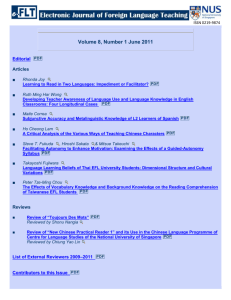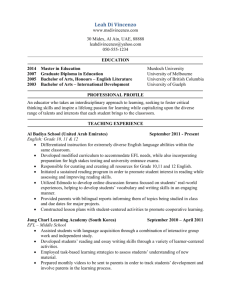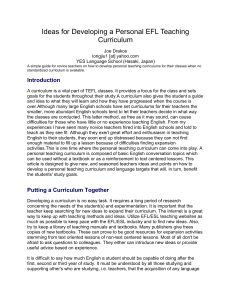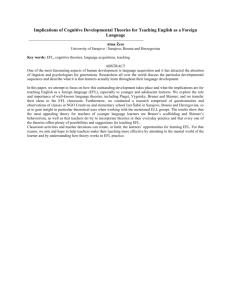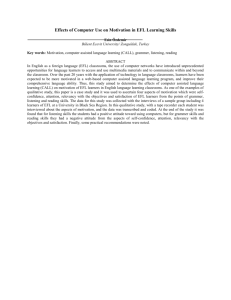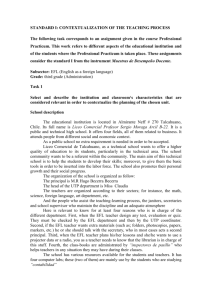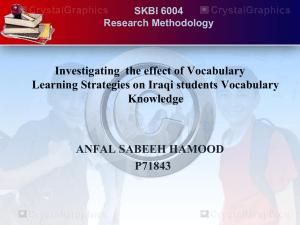Click here for English translation
advertisement
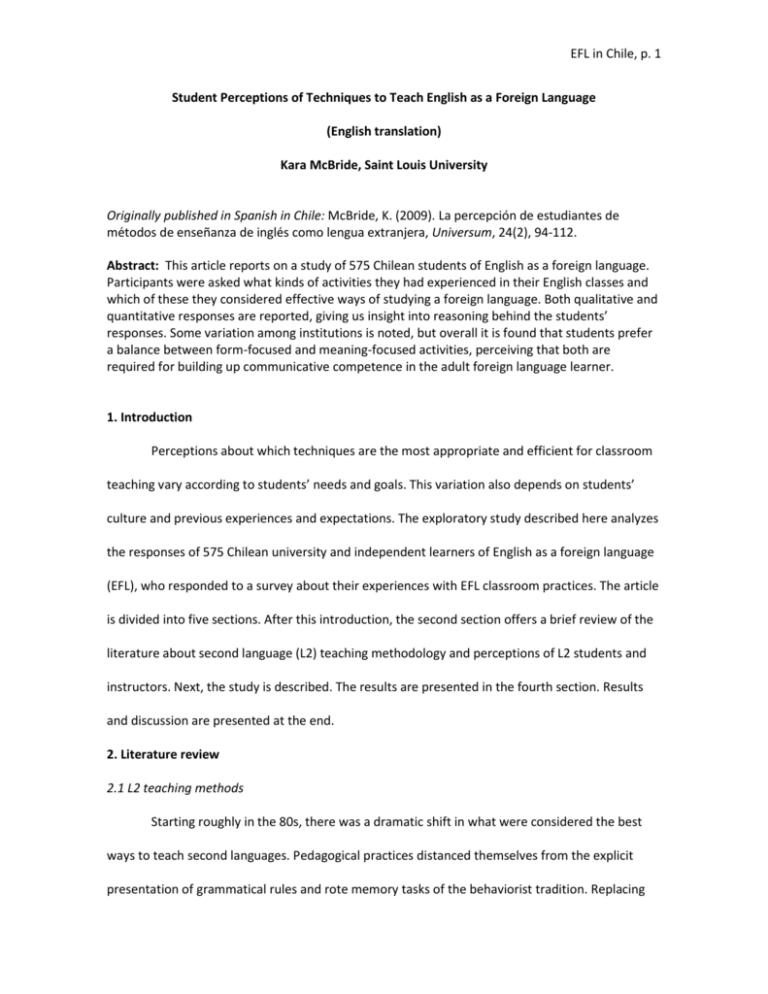
EFL in Chile, p. 1
Student Perceptions of Techniques to Teach English as a Foreign Language
(English translation)
Kara McBride, Saint Louis University
Originally published in Spanish in Chile: McBride, K. (2009). La percepción de estudiantes de
métodos de enseñanza de inglés como lengua extranjera, Universum, 24(2), 94-112.
Abstract: This article reports on a study of 575 Chilean students of English as a foreign language.
Participants were asked what kinds of activities they had experienced in their English classes and
which of these they considered effective ways of studying a foreign language. Both qualitative and
quantitative responses are reported, giving us insight into reasoning behind the students’
responses. Some variation among institutions is noted, but overall it is found that students prefer
a balance between form-focused and meaning-focused activities, perceiving that both are
required for building up communicative competence in the adult foreign language learner.
1. Introduction
Perceptions about which techniques are the most appropriate and efficient for classroom
teaching vary according to students’ needs and goals. This variation also depends on students’
culture and previous experiences and expectations. The exploratory study described here analyzes
the responses of 575 Chilean university and independent learners of English as a foreign language
(EFL), who responded to a survey about their experiences with EFL classroom practices. The article
is divided into five sections. After this introduction, the second section offers a brief review of the
literature about second language (L2) teaching methodology and perceptions of L2 students and
instructors. Next, the study is described. The results are presented in the fourth section. Results
and discussion are presented at the end.
2. Literature review
2.1 L2 teaching methods
Starting roughly in the 80s, there was a dramatic shift in what were considered the best
ways to teach second languages. Pedagogical practices distanced themselves from the explicit
presentation of grammatical rules and rote memory tasks of the behaviorist tradition. Replacing
EFL in Chile, p. 2
these were classes based on communicative activities where the focus was on the expression of
ideas and not the analysis of formal aspects of the language (Bell, 2005; Larsen-Freeman, 2003;
Richards & Rodgers, 2001; Zanón, 2007). The strong version of this communicative approach
rejected formal teaching of grammar and avoided error correction (Rao, 2002; Richards & Rodgers,
2001). This change in L2 teaching techniques was a radical reaction against the grammartranslation and audiolingual methods that been dominant before (Bell, 2005; Larsen-Freeman,
2003).
However these extreme methods may also be considered imperfect, because of their total
exclusion of the more traditional study of the structure of the target language (Bell, 2005; LarsenFreeman, 2003). Even in immersion situations, it has been found that students whose L2
experiences do not include negative feedback nor formal grammar instruction come out of these
programs with outstanding receptive skills but a substantial level of errors in L2 production (Swain,
2000).
Swain maintains that the meaningful contexts provided by communicative activities done
using materials that students can understand are necessary for second language acquisition (SLA),
but SLA demands the occasional and well-timed inclusion of explicit information about the
structure of the language and the errors of the learner. Swain is not alone in this call, given that
there has been a recent shift towards greater emphasis on the formal aspects of language within
the field of SLA (Schulz, 2001), specifically in terms of attention (Schmidt, 2001), focus on form
(Doughty & Williams, 1998; Lee & Valdman, 2000), and correction (Lyster, Lightbown, & Spada,
1999).
Realizing that neither the extreme method of exclusive grammatical analysis nor the other
method based solely on open communicative activities can fully teach a language in all of its
aspects, an instructor has to face the problem of how to find a balance among these two opposing
EFL in Chile, p. 3
tendencies in teaching. The solution that Larsen-Freeman (2003) proposes is something that she
calls grammaring. Classroom activities should be communicative, giving students the opportunity
to use the language for their own purposes, but these activities should be done in such a manner
that the students are aware of the correct use of specific forms and structure, understanding
these in terms of form, meaning, and socio-cultural purposes. However, Larsen-Freeman
emphasizes that many of the details as to how this style of teaching can be implemented depend
on the context within which teaching occurs.
A realization of the fundamental importance of the teaching context and the impossibility
that only one method of teaching could be the best method for every teaching situation has
brought to an end the rapid appearance of new, trendy teaching methods that characterized the
field of L2 teaching during many years. Kumaravadivelu explains it in this way:
Not anchored in any specific learning and teaching context, and caught up in the whirlwind
of fashion, methods tend to wildly drift from one theoretical extreme to the other. At one
time, grammatical drills were considered the right way to teach; at another; [sic] they
were given up in favor of communicative tasks. At one time, explicit error correction was
considered necessary; at another, it was frowned upon. These extreme swings create
conditions in which certain aspects of learning are utterly ignored, depending on which
way the pendulum swings (Kumaravadivelu, 2003, pp. 28-29).
Since the nineties, we are in a period which can be called a post-method era. Now each
teacher must select the combination of teaching techniques that work best within his or her
teaching context and with the population of students he or she works with, because, as
Kumaravadivelu (2003) explains,
...the concept of method... is too inadequate and too limited to satisfactorily explain the
complexity of language teaching operations around the world. Concerned primarily and
EFL in Chile, p. 4
narrowly with classroom instructional strategies, it ignores the fact that the success or
failure of classroom instruction depends to a large extent on the unstated and unstable
interaction of multiple factors such as teacher cognition, learner perception, societal
needs, and institutional constraints, all of which are inextricably interwoven (p. 29).
The present study focuses on the second factor named here: learner perception.
2.2 Teacher and student perceptions
In investigating the success different L2 teaching practices have in different contexts,
students are particularly important, because they constitute the principal factor that defines the
essence of the difference between teaching contexts. It is therefore essential to know something
of the perceptions that students have about the teaching practices that they encounter in their L2
classes. Student beliefs1 about SLA can affect their motivation, their receptivity to different
classroom activities, their learning strategies, and ultimately, their outcomes (Arredando &
Rucinski, 1996, Brown, 2009; Horwitz, 1988; Schulz, 2001; Woods, 2003). There is furthermore
evidence that frequently there are serious differences of opinions between instructors and
students as to which activities promote SLA (Block, 1994; Nunan, 1986).
In the United States it has been found that teachers of foreign languages (French, German,
Spanish, etc.)2 prefer techniques associated with the communicative approach, disfavoring explicit
grammar instruction and explicit error correction, while their students often have opposing
preferences (Bell, 2005; Brown, 2009; Schulz, 1996). Students in other contexts, however, may
have different expectations. Schulz (2001) used a survey from a previous study (Schulz, 1996) to
1
“Students whose instructional expectations are not met may consciously or subconsciously question the
credibility of the teacher and/or the instructional approach” (Schulz, 1996, p. 349).
2
When it is important to differentiate between the two, the term “foreign language” is used to describe the
situation of teaching a language that is not the official language or extensively spoken language in the
country where the language is studied, while “second language” is used to describe studying a language in a
country where that language is the majority’s mother tongue. The term “second language” is preferred
when it is not important to distinguish between these two contexts.
EFL in Chile, p. 5
compare the perceptions of students and teachers of English in Colombia with those of students
and teachers in the United States. She found that among the Colombians there was a more
favorable attitude towards grammar instruction than was found among students of foreign
languages in the United States.
Opinions differ in other situations of English as a second language (ESL) study. The Chinese
students in Rao’s (2002) study were found to prefer a combination of methods. At the same time,
they were uncomfortable with techniques associated with the communicative approach and they
disliked activities that were based on music. In contrast, the Puertorican students in Green’s
(1993) study prefered communicative activities, and there was a correlation between the
perceived effectiveness of an activity and the extent to which the students enjoyed it. The subjects
of Loewen et al. (2009) were foreign language students in the United States studying a variety of
languages. These students were interested in grammar, but they required that it always be
connected with realistic situations and authentic communication; they rejected activities that
included a large amount of memorization without a meaningful context. Differences were found
among groups of students studying different target languages. This is probably due in part to
differences in the students’ expectations about how they would use the languages in the future, as
well as differences in the extent to which the students could use the target language in real-life
situations while they were studying.
The factors that determine students’ attitudes change over time (Brosh, 1996; Horwitz,
1985). In Chile, for example, policies about the study of EFL have been developed with a
background belief that students will have many opportunities to use English and that “English
opens doors,” as is the name of the national EFL program (http://www.ingles.mineduc.cl). In her
study on EFL instruction in Chile, McKay (2003) describes how the country has found ways to
EFL in Chile, p. 6
adapt and redefine the communicative approach in the Chilean context more than has been
observed in other countries where English is taught as a foreign language.
3. The study
The purpose of the present study was to learn more about the perspectives of adult EFL
students in Chile. Three questions guided the investigation:
1. What teaching practices have these students experienced in their English classes, both in their
current classes as well as at the primary and secondary levels?
2. Which of these activities do the students consider most and least effective in promoting their
acquisition of EFL?
3. To what extent is there variation among students at different institutions?
3.1 Participants
Participants were recruited for a larger study about listening comprehension (McBride
2007, 2008) which was carried out online (except for initial recruiting and some follow-up, face-toface interviews). Recruiting was done in English classes at six universities in Chile, although it is
clear that word about the study got out and many participants learned about the study through
means other than in-class recruiting. Some students started the study as an in-class activity, and
some received extra credit for participating. The majority, however, did the study entirely on their
own.
In the end, the survey that provides the data for the present article was answered by 575
people who could clearly be identified as university students or professionals who were studying
English independently. Of them, 229 were students from the University of Talca, 144 from the
University of Rancagua, 64 from the University of Concepción, 40 from the Autonomous Southern
EFL in Chile, p. 7
University in Talca, 29 from the Southern University of Chile, and 20 from the University of Andrés
Bello. An additional 49 participants were professionals who were studying English on their own
(referred to later as “independent learners”). The majority of the participants from the University
of Concepción, the Autonomous Southern University, the Southern University of Chile, and the
University of Andrés Bello were majoring in English.
3.2 The survey
The survey (see appendix) had questions about the frequency with which the participants
encountered specific activities: “act out pre-written conversations;” “study grammar, look at
grammar rules, and practice structures;” “memorize and recite;” and “write and present skits of
your own.” Participants chose between “never,” “sometimes,” “often,” and “almost always,” with
reference to not only their current classes but classes they had taken in the past.
After this list of five activity types, there was a space for participants to write in other
activities that they did in class. This was followed by another two open-ended questions about
teaching practices in their English classes: “Which of these seem to you to be good activities?” and
“Which of these are in your opinion bad ways to study a language?” Although there were other
questions on the survey, it is primarily the answers to these questions that are used to answer the
research questions listed above.
4. Results
Table 1 (see appendix) shows the responses to the first group of questions about the five
specified types of activities in the questionnaire. Table 2 (See appendix) reports the results where
EFL in Chile, p. 8
the participants could specify in a text box which other activities they did in their English classes.3
Only 26% of those surveyed answered this question, while 84% of the participants answered the
open questions about their opinions as to which of these activities were good and bad methods
for studying a language. Table 3 reports the positive answers, and Table 4 presents the negative
answers.
What follows is a summary of the most notable information about the frequency of the
various pedagogical practices, accompanied by relevant and representative quotes from the
responses to the questions about their opinion about the efficacy of those practices.
4.1 The five pre-established categories
As can be seen in Table 1, the most common activity of the five choices is that of studying
and practicing grammar explicitly. Table 3 shows that grammar activities were the most commonly
mentioned beneficial activities, although the majority of the comments of this type emphasize the
need for grammar as a foundation for primarily communicative activities, as this student from the
Autonomous Southern University wrote: “Estudiar la gramática y luego poner en practica
mediante ejercicios ya sean escritos o orales es una buena manera de aprender; solo escuchar
ingles y no practicar es una mala manera de aprender” (Studying grammar and then putting it into
practice either through written or oral activities is a good way to learn; only hearing English and
not practicing it is a bad way to learn).4
3
The table shows the percentage, in every group, that mentioned each activity. It is presented in this
manner so as to permit comparisons between the groups despite the difference in sample sizes. For
example, only 2.2% of the participants from the University of Talca mentioned reading as a class activity.
This percentage represents five students. At the University of Andrés Bello, only three students mentioned
reading, but since the sample of participants from that university was only 20 students, this number is
equivalent to 15% of the responses.
4
All quotes are reproduced exactly as the participants originally wrote them online. As the reader will see,
they contain many errors.
EFL in Chile, p. 9
Those few who said something negative about studying grammar indicated that they
considered this to be a problematic practice only when it was done in an exclusive manner, as one
student from Talca explained, “Las malas maneras es estudiar estructuras gramaticales y reglas sin
poderlas practicar en diálogos mas complejos” (Bad ways are studying grammatical structures and
rules without being able to practice them in more complex dialogs). Another student from the
University of Andrés Bello wrote, “No me parece muy bueno solo aprender reglas gramaticales
porque, por lo menos yo, tengo grandes dificultades para conversar en inglés” (I don't think it's
very good to only learn grammatical rules because at least for me, I find conversing in English to be
very difficult).
A number of students classified grammar as “fundamental.” This contrasts with
participants’ emphatic rejection of rote memory activities. This type of activity stands out as being
by far the most mentioned type of activity in the open question about participants’ opinions on
ways of studying and learning English (see Table 4), although the average frequency reported
indicates that these activities were relatively uncommon in class (see Table 1). Almost all of the
explanations given had to do with a lack of meaning: “Me parece malas maneras el hecho de tener
que memorizar y recitar algo que tal vez no entiendo....” (I think having to memorize and recite
something that maybe I don't understand is a bad way) (University of Talca student).
For many, the word “memorize” is in opposition to the concept of acquisition. As one
student from Rancagua indicated, “Lo que me parece mal es memorizar y recitar algo, porque de
verdad no estas aprendiendo nada” (What seems bad to me is to memorize and recite something,
because you’re not really learning anything), and another from Southern University of Chile: “Casi
todas son buenas actividades exceptuando lo de ‘Memorizar y recitar’, porque memorizando no se
aprende” (Almost all of the activities are good except for ‘memorization and recitation,’ because
you don’t learn by memorizing).
EFL in Chile, p. 10
Other participants said that memorized items are quickly forgotten, as in the words of one
student from the Autonomous Southern University, “...Aprendiendo de memoria, ya que con
frecuencia se olvida, a mi juicio es mejor aprender la formula y luego aplicarla” (...Memorization,
because you often forget it, in my opinion it’s better to learn the formula and then apply it).
Memorization appears to be conceived of as something that has no meaning or context or
application for the student. One independent learner explained that memorization lacks the
ingredient of effort that is necessary to make something memorable:
He aprendido mucho más cuando tengo dudas o problemas con el vocabulario y
estructuras gramaticales, buscando respuesta en diccionarios o con personas que manejan
más conocimientos que yo, eso no lo olvido más, debe ser el aprendizaje producto de la
experiencia (I have learned much more when I am confused about or have problems with
vocabulary and grammatical structures, looking for an answer in dictionaries or from
people who know more than I do, this you don't forget, learning should be the product of
experience).
The commentaries of the few (nine) who indicated that memorization can be useful
suggested that memorization is necessary in order to do things such as learn verb conjugations.
Another commentary, from a student of the University of Andrés Bello, was that memorizing and
reciting something serves as good pronunciation practice. This student added that it is good to
exercise one’s memory.
The second most frequent activity of the list of five is small group work. When participants
explained why they considered small group work to be a good way to study English, they showed
that for them small group work means conversation practice. Some mentioned the help and the
attention of classmates that is possible through small group work, as one student from the
University of Rancagua said, “Me parece muy buena forma de estudiar ingles creando dialogos y
EFL in Chile, p. 11
trabajando en pequeños grupos para fortalecer posibles debilidades junto a compañeros” (I think
it is very good to study English by creating dialogues and working in small groups to work on one’s
weaknesses together with one’s classmates). Another student from that University wrote, “Lo
buen es que como trabajamos en grupo podemos audarnos mutuamente en las falencias que se
presentan” (The good thing is that since we work in groups we can help each other in whatever
problems we have).
Of the four who identified group work as a class activity of little value, only one explained:
“Las malas pueden ser trabajar en grupos de muchas personas por que causa desorden y siempre
el que sabe mas ingles lo hace todo” (A bad activity might be working in too big of a group because
it can be chaotic, and always the one who knows the most English ends up doing everything). This
answer suggests that smaller groups would not necessarily be problematic for this student from
Rancagua. Concern about a mismatch among group members also appeared in one of the
comments that identified group work as a positive classroom activity. This student from the
University of Talca added in parentheses, “Ojalá sean de un mismo nivel” (Hopefully they’re all at
the same level).
Performing pre-written dialogues was another fairly common activity. Participants spoke
of this activity as something dynamic that at the same time provides models of real English use
and occasions for practicing new vocabulary: “A mi me gustan las conversaciones preescritas,
porque ayuda a practicar mi vocabulario y a tener un ingles mas fluido. Por el contrario, no me
gusta memorizar, porque no es muy natural, no hay dinamismo” (I like pre-written dialogues
because it helps me practice my vocabulary and increase my fluidity. On the other hand, I don't like
to memorize because it's not natural, there's no dynamism) (student from Concepción). Other
students observed that this type of activity can be a good opportunity to practice pronunciation.
The University of Talca student who included this technique among bad ones wrote, “Se actúa sin
EFL in Chile, p. 12
saber lo que se habla” (You act without knowing what you're saying). The student from the
University of Concepción who identified this type of activity as bad had the same objection. Again
it is possible to note the insistence on not practicing a language without a meaningful context.
Last of the list of five proposed activity types, the category that was reported to be the
least frequently used was writing and presenting skits. The comments about this practice showed
that what made this activity attractive above all it is the fact that the students create their own
product. Another advantage that was mentioned was that this type of activity has both a written
and a spoken component. A woman from the University of Andrés Bello stated,
Representar mini dramas de mi propia creación, lo hice una vez en el instituto que estudié
inglés y fue muy útil porque perdí la verguenza de hablar en otro idioma, si pronunciaba
mal o erraba no era ‘yo’ era el personaje, perdi la verguenza de hablar en público gracias a
la realización de sketchs (Presenting skits, I did that once in the institute where I studied
English and it is very useful because I learned not to be so shy about speaking another
language, if I pronounced something or made a mistake it wasn't "me" it was the
character, I lost my fear of speaking in public thanks to doing skits).
The only person who reported not liking this type of activity explained, “No me gusta mucho
hablar inglés, por tanto no me gusta mucho la presentación de mini dramas de mi propia creación”
(I don't like speaking English very much, and so I don't like presenting skits that I wrote).
4.2 Other activities
Nine categories emerged from the responses to the open-ended question about what
other activities students did in their English classes. Unlike the data in Table 1, in Table 2 there was
a great deal of variation among the institutions. The categories in Table 1 are more general – more
EFL in Chile, p. 13
like styles of teaching – whereas what the participants indicated in this open-ended question were
more specific activities.
The type of activity that was most often mentioned here was working with songs. Among
these responses there were several specific types of activities: listening, singing, translating,
learning, and creating. This is also the only activity that a number of students said that they had
done by themselves. Surprisingly, despite being mentioned many times for this question, working
with songs was not often explicitly mentioned among the activities that were especially good or
bad for learning.5
The other frequently mentioned activities were reading, listening comprehension
activities, conversation, translation, watching movies and videos, writing, presenting in class, and
using computers. Table 2 does not include the activities that were rarely mentioned: vocabulary
activities (3 times), pronunciation (3), and working with handouts and answering the teacher's
questions (4). It is likely that this last category actually represents the way in which a great deal of
time was spent in many of their English classes, but that it was so common that many participants
did not think that it was necessary to mention it.
Computer activities were mentioned only a few times, but this can be explained by the
fact that earlier in the survey there was a specific question about computer assisted language
lessons. Forty-six percent of the participants indicated that they had used a CD-ROM, computer
program or website to study English. Given that the answer to this question appears to be more
reliable, computer activities are not included among the data in Table 2.
Besides uses of the Internet as a way of acquiring more information and materials,
participants reported using computers mostly for tasks that could be repetitive. What was
5
Every mention of song activities, then, appears in Tables 3 and 4 under the skill that was specifically
mentioned in the answer, such as for example listening comprehension or translation.
EFL in Chile, p. 14
attractive about the computer programs was primarily that they could be used to help with
memorization which, as we have seen, has very little appeal for the students.
There is only one activity in Table 4 (activities that participants considered unhelpful) that
was not one of the original five types of activities listed on the survey but was instead introduced
by participants, and that is listening comprehension activities. A look at the original comments
reveals that for the two students who answered in this way, this type of activity can be
problematic when it is not given a meaningful context.
4.3 Assessment of the activities
As reported in Table 3, the most common answer to the question of which activities aid in
learning was “All of them.” Seventy-three people expressed the opinion that all of the activities
were useful, adding in almost every case that it is necessary to have a mix of methods and a
balance between activities in order to learn English: “Yo creo que todos en su justa medida son
buenos” (I think that all of them are good in the right amount) (University Austral). Another
student from Talca characterized the activities in this way: “Buenas, en realidad todas las
mencionadas en la pagina anteriormente... Malas, realizarlas de a una por que aprender no es solo
como se escribe o como se habla, requiere introducirnos completamente en el idioma” (Really all
of the activities mentioned on the previous page are good. But a bad way to learn English is to do
only one type of activity because learning isn’t just how you write or how you speak, we need to be
completely immersed in the language).
Another common response (34 responses) was to say that the most important part of an
activity is that it be dynamic. The participants said, for example, “Las actividades creativas y
entretenidas, es decir que incentiven el aprendizaje. Las malas maneras es una cosa rutinaria”
(Creative and fun activities, that motivate you to learn. A bad way to learn is through something
EFL in Chile, p. 15
routine) (University of Talca). Over and over again these participants spoke of the importance of
dynamism and creativity for motivating students and how ineffectual mechanical activities are in a
class.
5. Discussion and implications
The central message in the results is that the students want to use English to
communicate. They considered grammar to the essential but not as an end in itself, rather as
something fundamental for developing communicative competence. All pedagogical activities
have, according to them, the potential to contribute to this development. They considered English
as a complex combination of its related skills that together express what is communicated.
Without meaning, there is no communication, and the skills lose their importance. Without a
meaningful context, it is not possible to understand how the words and structures affect the
meaning of what is expressed. The strong rejection of memorization tasks comes from the lack of
meaning that the participants associated with that kind of activity.
Meaningfulness was not limited only to message but extended to the reasons for using
rules. As one student from the University of Rancagua wrote, “Me parece mal cuando no te
aclaran las dudas y no explican bien cuando y cuando no ocupar ciertas palabras en ingles, para
poder armar con coherencia las oraciones o textos” (I think it's bad when they don't answer your
questions or explain well when and when not to use certain words in English, so we can coherently
construct sentences or texts). Thus form and structure both matter because from them comes
meaning. These principles fit with Larsen-Freeman’s (2003) idea of grammaring, described above,
in which meaning, use, and form are inseparably intertwined in the language and it is necessary to
take all of them into account in classroom activities.
EFL in Chile, p. 16
This then can answer the question presented in the third section of this article as to which
teaching activities the students found to be the most and least useful for their English acquisition.
Like the English students in Puerto Rico in Green’s (1993) study and the ESL students in the United
States in Loewen et al. (2009), the Chilean students in this study were interested primarily in
communication but also in all class activities that could help them reach this goal. In agreement
with Kern’s (1995) results, it can be seen that the beliefs of the students in the present study
reflect current trends in second language pedagogy. It is possible that this is because the students
have had experiences with teachers who teach according to the most recent theories of second
language acquisition.
The other research questions asked which types of activities the students had experienced
in their English classes and how much variation was to be found among teaching institutions.
Tables 1 and 2 summarize the answer to the first question, although it is necessary to keep in mind
that it is possible that the students’ answers were influenced as much by what they remembered
as by what was in fact most commonly practiced. For example it might be that the song activities
were not especially common in the participants’ classes but rather were simply remembered more
frequently and only for that reason figure so prominently in their responses.
Since the survey questions asked about what the students had experienced, there was
little opportunity for the participants to talk about what was lacking in their classes. Despite this,
pronunciation emerged as an area where the students would like to have more practice. For some,
knowing more about correct pronunciation was key in order for them to be able to speak less selfconsciously.
Continuing now to the question about variation, we can note relatively little variation
among the groups of participants with respect to the first five categories. It is possible that the
manner of indicating frequency in this section of the survey (indicating "never," "sometimes,"
EFL in Chile, p. 17
"often," or "almost always") does not allow for detailed analysis. Although the variation appears to
be slight, it is still worth noting. For example, the two universities where students reported
studying grammar the most, Autonomous Southern University and Andrés Bello, are institutions
where the students majored in English, while the independent learners and the students from the
University of Rancagua, where the classes were either optional or at a very low level, reported
studying grammar much less. One explanation for this difference might be that the accuracy
expected of the two groups was different as well as the level of patience that the teachers
believed that they could demand of their students. Also, the group of independent learners in
general tended to respond differently than the students. Their comments showed a greater level
of awareness of the learning process, which likely is due to a greater level of maturity.
There was more variation among participants with respect to the activities that they
themselves named (Table 2), given that the activities in this section were generally more specific
than the five categories presented before. The activities in which most variation was seen, given
their standard deviations, are writing, presentations, and the use of songs. No doubt a large part
of the variation is due to the difference in teaching styles among the instructors, and another part
of this phenomenon is the differences between academic programs at the universities. It is
difficult to know what percentage of this difference has to do with the university versus grade
school programs, since participants talked about both. If the primary source of the variation was
the instructor or the program, it is likely that the differences in activities used in class had much to
do with the different needs and goals of the students. Presentations, for example, were more
common among students who were majoring in English. Given that many of those students would
become English teachers in the future, they have more need to practice presenting in front of a
class.
EFL in Chile, p. 18
Activities are chosen according to student interests, but they must serve the students’
fundamental goal, which, for the participants of this study, is communicative competence.
Participants expressed frustration with activities that did not appear to them to be helping them
to develop their communicative competence. Students whose expectations are not met might
doubt the credibility of their instructor and his or her way of teaching (Schulz, 1996). Therefore,
communication between teachers and students is essential. This is true first because instructors
need to be aware of the students’ objectives, and secondly because, even if all participants have
the same goals, students may not always understand the intention of some classroom practices. A
quick conversation between instructors and students can resolve misunderstandings and improve
the students’ perception of the class, which in turn can improve the students’ motivation and,
ultimately, the students’ performance in class (Brown, 2009).
EFL in Chile, p. 19
References
Arredondo, D. E., & Rucinski, T. T. (1996). Epistemological beliefs of Chilean educators and school
reform efforts. Documento presentado en el Tercer Encuentro Nacional de Enfoques
Cognitivos Actuales en Educación.
Bell, T. R. (2005). Behaviors and attitudes of effective foreign language teachers: Results of a
questionnaire study. Foreign Language Annals, 38(2), 259-270.
Block, D. (1994). A day in the life of a class: Teacher/learner perceptions of task. System, 22, 473486.
Brosh, H. (1996). Perceived characteristics of the effective language teacher. Foreign Language
Annals, 29(2), 125-136.
Brown, A. V. (2009). Students’ and teachers’ perceptions of effective foreign language teaching: A
comparison of ideals. The Modern Language Journal, 93(1), 46-60.
Doughty, C., & Williams, J. (Eds.). (1998). Focus on form in classroom second language acquisition.
New York: Cambridge University Press.
Green, J. M. (1993). Student attitudes toward communicative and non-communicative activities:
Do enjoyment and effectiveness go together? Modern Language Journal, 77(1), 1-10.
Horwitz, E. K. (1985). Using student beliefs about language learning and teaching in the
foreign language methods course. Foreign Language Annals, 18(4), 333-340.
Horwitz, E. K. (1988). The beliefs about language learning of beginning university foreign language
students. The Modern Language Journal, 72(3), 283-294.
Kern, R. G. (1995). Students’ and teachers’ beliefs about language learning. Foreign Language
Annals, 28(1), 71-92.
Kumaravadivelu, B. (2003). Beyond methods: Macrostrategies for language teaching. New Haven:
Yale University Press.
Larsen-Freeman, D. (2003). Teaching language: From grammar to grammaring. Boston:
Thomson Heinle.
Lee, J., & Valdman, A. (2000). Form and meaning: Multiple perspectives. Boston: Heinle.
Loewen, S., Li, S., Fei, F., Thompson, A., Nakatsukasa, K., Ahn, S., et al. (2009). Second language
learners’ beliefs about grammar instruction and error correction. The Modern Language
Journal, 93(1), 91-104.
Lyster, R., Lightbown, P. M., & Spada, N. (1999). A response to Truscott’s “What’s wrong with oral
grammar correction.” Canadian Modern Language Review, 55, 457–467.
EFL in Chile, p. 20
McBride, K. (2007). The effect of rate of speech and CALL design features on EFL listening
comprehension and strategy use. Tesis doctoral, University of Arizona,
Tucson, Arizona, EE.UU.
McBride, K. (2008). Adaptive and maladaptive strategy use in computer-assisted language learning
activities for listening comprehension. Indian Journal of Applied Linguistics, 34(1-2), 65-86.
McKay, S. (2003). Teaching English as an international language: The Chilean context. ELT
Journal, 57(2), 139-148.
Nunan, D. (1986). Communicative language teaching: The teacher’s view. Paper presented in the
RELC regional seminar.
Rao, Z. (2002). Chinese students’ perceptions of communicative and non-communicative
activities in EFL classroom. System, 30, 85-105.
Richards, J., & Rodgers, T. (2001). Approaches and methods in language teaching (2nd ed.).
Cambridge: Cambridge University Press.
Schmidt, R. (2001). Attention. En P. Robinson, M. H. Long & J. C. Richards (Eds.), Cognition and
second language instruction (pp. 3-32). Cambridge, England: Cambridge UP.
Schulz, R. A. (1996). Focus on form in the foreign language classroom: Students’ and teachers’
views on error correction and the role of grammar. Foreign Language Annals, 29(3), 343364.
Schulz, R. A. (2001). Cultural differences in student and teacher perceptions concerning the role of
grammar instruction and corrective feedback: USA-Colombia. The Modern Language
Journal, 85(2), 244-258.
Swain, M. (2000). French immersion research in Canada: Recent contributions to SLA and applied
linguistics. Annual Review of Applied Linguistics, 20, 199-212.
Woods, D. (2003). The social construction of beliefs in the language classroom. En P. Kalaja & A. M.
Ferreir Barcelos (Eds.), Beliefs about SLA: New research approaches (pp. 201-230). Boston:
Kluwer Academic Publishers.
Zanón, J. (2007). Psicolingüística y didáctica de las lenguas: Una aproximación histórica y
conceptual. Revista Didáctica ELE, 5.
EFL in Chile, p. 21
Appendix: The survey
First name: ________________
Family names: ________________
What institute do you currently study in? ________________
How many years have you studied English? {drop-down menu of 1 to 20}
From 1-10 (1=very bad, 10=outstanding), how would you rate the quality of English instruction at
your grade school? {drop-down menu of 1 to 10}
Have you taken English classes outside of your school (like, for example, private lessons)?
Yes
No
Have you used a CD-ROM, computer program, or website for studying English?
Yes
No
If so, describe it: ________________
What kinds of activities have you done in your English classes (in grade school and afterwards)?
Indicate the types of activities that you have done and how often you did them in class.
never
Act out pre-written
conversations
Study grammar,
look at grammar
rules, and practice
structures
Work in small
groups
Memorize and
recite
Write and present
skits of your own
Other:
______________
sometimes
often
almost
always
EFL in Chile, p. 22
Which of these seem to you to be good activities? Which seem to be bad ways of studying a
language?
__________________
When you listen to music in English, do you try to understand the lyrics?
Yes
No
If so, how do you do it? ________________
When you watch television or movies in English, do you try to understand what they are saying
without the help of subtitles?
Yes
No
Can you?
Yes
No
Have you ever traveled somewhere where you had to communicate in English?
Yes
No
On a scale of 1-10 (1=I don’t care at all, 10=it’s the most important thing for me), how much do
you care about bettering your English? {drop-down menu of 1 to 10}
On a scale of 1-10 (1=nothing, 10=fluent), how do you rate your ability to understand English
spoken by native speakers of English? {drop-down menu of 1 to 10}
On a scale of 1-10 (1=nothing, 10=fluent), how do you rate your ability to read in English? {dropdown menu of 1 to 10}
Have you ever studied for the TOEFL or any other international placement exam of English?
Yes
No
Have you ever taken this type of exam?
Yes
No
If so, how did you do? ________________
EFL in Chile, p. 23
Table 1: Frequency averages* for each activity, by group
Talca
Rancagua
Concepción
Autonomous
Southern
A. Bello
Independent
Number of
participants
Study
grammar
Small group work
Acting out prewritten dialogues
Memorize
and recite
Write and
present skits
229
144
64
40
29
20
49
2.14
1.92
1.98
2.3
2.21
2.35
1.82
1.54
1.98
1.86
1.78
1.66
2
1.06
1.35
1.7
1.31
1.63
1.66
1.6
0.88
1.02
1.42
0.95
1
1.48
1
1.02
0.89
1.24
0.64
0.75
0.62
0.95
0.43
*“Never”=0; “sometimes”=1; “often”=2; “almost always”=3.
Table 2: Percentages of each group’s responses that mention these activities
Talca
Rancagua
Concepción
Autonomous
Southern
A. Bello
Independent
Songs
8.3
2.8
17.2
6.9
10.0
7.5
8.2
Reading
2.2
0.7
3.1
6.9
15.0
2.5
4.1
Listening
4.4
0.7
6.3
6.9
5.0
5.0
2.0
Conversation
3.5
1.4
4.7
6.9
10.0
2.5
2.0
Translate
3.1
0.0
0.0
0.0
0.0
2.5
4.1
Videos
1.7
1.4
0.0
6.9
0.0
0.0
0.0
Writing
2.6
0.0
6.3
3.4
10.0
2.5
2.0
Presentations
0.9
1.4
9.4
6.9
15.0
10.0
0.0
EFL in Chile, p. 24
Table 3: Percentages of each group’s responses naming each type of activity as beneficial
All
Talca
Rancagua
Concepción
Autonomous
Southern
A. Bello
Independent
9.2
8.3
9.4
24.1
35.0
2.5
16.3
Grammar Prewritten
9.2
12.3
3.5
8.3
14.1
6.3
24.1
3.4
5.0
10.0
17.5
0
18.4
10.2
Groups
9.6
6.3
4.7
10.3
5.0
10
6.1
Conversation
6.6
6.9
7.8
6.9
5.0
17.5
8.2
Skits
5.7
6.3
4.7
3.4
15.0
12.5
16.3
Dynamism Multimedia
4.4
1.8
6.9
1.4
1.6
1.6
13.8
0
15.0
5.0
5
0
8.2
2
Table 4: Percentages of each group’s responses naming each type of activity as not helpful in SLA
Memorization Grammar
Talca
Rancagua
Concepción
Autonomous
Southern
A. Bello
Independent
29.4
13.2
31.3
17.2
20.0
17.5
30.6
2.2
2.1
1.6
0.0
5.0
0.0
0.0
Groups Pre-written
dialogues
0.4
0.4
0.7
0.0
3.1
1.6
0.0
0.0
0.0
0.0
0.0
0.0
0.0
0.0
All
Listening
0.4
0.0
0.0
0.0
5.0
0.0
0.0
0.0
0.7
0.0
0.0
0.0
2.5
0.0
Listening
1.8
0.7
0
0
0.0
2.5
4.1
Memorization
0
2.1
1.6
0
5.0
0
2
Writing
0
0.7
0
0
5.0
5
0
